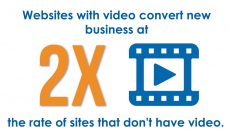Customer experience is increasingly where the action is — whether your customers are consumers or IT decision-makers. Since watching your videos is part of the sales process, it makes sense to consider the video customer experience of the numerous influencers and IT decision-makers involved in the sales process.
“Don’t tell them what they already know, just tell them what they want to know.” This is the first rule to keep videos for IT decision-makers short. Maybe that’s two rules, but enforcement is hard either way. It’s particularly hard to say what each person on a buying team starts out knowing or wants to know. Not everyone is out to acquire “product knowledge.” Some good general guidelines on what IT decision-makers want to learn can be gleaned from the wealth of statistical factoids in IDG’s Guide to engaging IT decision-makers in the digital-first age, an infographic which summarizes the findings of several recent in-depth studies. Here are a few of the findings worth taking into account when you plan video content for customer engagement.
It takes a whole semester
The average sales process is 4.8 months, during which you’ll need to reach 16 influencers, half of them from IT, half from the business. You want to avoid “marketing hype/buzz words” — most IT decision-makers (56%) have problems with that. 90% put a high value on “tailored” content — by tech platform, industry, or company size.
Many decision-makers (78%) say end-users are playing an increasing role in process. 71% said they would like to have”more educational resources” from vendors, tailored for non-technical functions. 85% are “more likely to consider a vendor who educates them in each stage of the decision process.” The average decision-maker downloads five “educational assets.”
Keep in mind that not every learner needs to master the subject. For some, it’s enough to tick a few boxes. Some will want summary content. For example, not everyone needs to read implementation guides — but most decision-makers will want to get an idea of how long it takes and how disruptive it is. Video is useful here — we’ve made videos based on executive summaries of white papers, for example. In light of the fact that many decision-makers (40%) said they hesitate to download content for fear of a followup phone call, it’s worth considering that an ungated video summary might be a good way to nudge buyers along on their journey.
A better webinar
A favorite content type of IT decision-makers (58%) is the “video/webinar demo” in spite of the fact that most webinars are pretty slow going. You can make a much better user experience of recorded “webinar/demos” by adding bookmarks or chapter headings. Wouldn’t you, as a potential user of a software tool, appreciate being able to skip the introductory stuff and jump right to the actual demo? You can do that with open source software (and lots of other ways).
Overall: keep it short, tailor content, and offer whatever educational resources they might need — webinar demos included. Tune your marketing to what IT decision-makers need and you will likely see it pay off.







